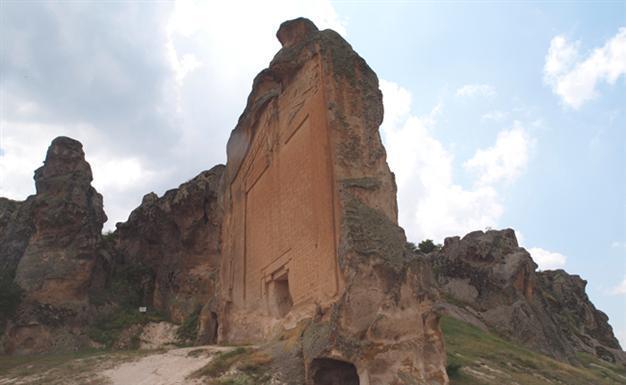An old Phrygian city, Eskişehir
WILCO VAN HERPEN ESKİŞEHİR -Hürriyet Daily News

When you walk around in Midas the first thing that attracts your attention is a huge wall carved as if it is a tomb. According to a guide, this was no tomb but rather a place of worship. Photo by Wilco van Herpen
I met Murat and Yekta in the central Anatolian province of
Eskişehir (Old City). They invited me for a drink in one of their bars and we started talking. They are an interesting couple, traveling abroad a lot and sometimes inviting the students who work for them to join them on trips. It’s all on the house, or better, on the bar. The places they run do give you a feeling of being among people who like to
travel.
Where I stayed, a video was playing non-stop showing their latest trip, and a slideshow was running of all the places they have been to. The place was decorated with all different kinds of souvenirs they have picked up while traveling over the years. One of the most remarkable souvenirs I saw was a “koteka” (a special sheath to cover men’s genitals) that they obtained in Papua New Guinea.
After we ate at their bar, Murat suggested we take a walk and see something of the nightlife in Eskişehir. The next day the sun was shining bright and there was no wind. The place I had to go was Midas, near Çifteler, about 90 kilometers away from Eskişehir. I felt knackered; my mouth was dry as a desert, my head light as a cloud. I climbed in my camper and drove off. The first part of the road was a normal tar road but the last stretch was a bad piece of road. It took all my skills not to hit any potholes. Finally I was there. The famous Phrygian city.
The
Phrygians are not very well-known in Turkey. Everybody knows about the Ottomans, Byzantines and Hittites, but you have to find a true history lover to hear stories about the Phrygians. Eskişehir, for example, was founded by the Phrygians around 1000 BC. But King Midas is undoubtedly the most famous Phrygian, as legend has it that was able to turn whatever he touched into gold. In one of the stories about Midas he even changed his daughter into gold when he touched her.
Around the 7th century BC the Phrygians settled at what is now known as Midas City, and the place grew and flourished until the end of the century, when it was demolished during a war with the Persians. It took the Phrygians a while to recapture the city but from then on they held it until the Romans came and destroyed the glorious city.
A place of worshipWhen you walk around in Midas the first thing that attracts your attention is a huge wall carved as if it is a tomb. This wall has an enormous crack on one side due to erosion and it looks impossible to restore to me. Surely something must be done, or that part will fall down and even more erosion will occur. According to a guide, this was no tomb but rather a place of worship. The general idea is that during special ceremonies the Phrygians would get a beautiful golden statue from a secret and sacred place and put it in the niche of this giant wall.
Further away there are some more gorgeous carvings, but then I found something that looked like a basin. The funny thing was that in this “reservoir” the Phrygians had carved a long stairway going down to the bottom making it look like a tunnel. It was amazing to see how those people had managed to dig such a big basin with the primitive tools of the time. I wondered if they really used primitive tools, because when you look at the work that had to be done you just feel admiration. It must have taken months, maybe even years to make those basins.
A bit later I discovered another one. I walked down the stairs and once I was down at the bottom of the basin I looked up. This was really amazing, what a job. I walked into the tunnel but it was impossible to see where it led to since the tunnel had collapsed. On one of the sides of the basin I found a rock carving. Those people were really exceptional. Why would someone carve the figure of a lion in a place that (most probably) would be under water? Every time I visit such an old historical place I leave with more questions than answers. Archeology must be a very frustrating job, so many questions and not enough answers.
This was one of my unforgettable trips, I thought. I was highly impressed by the skills of the Phrygians and their taste in decoration.
